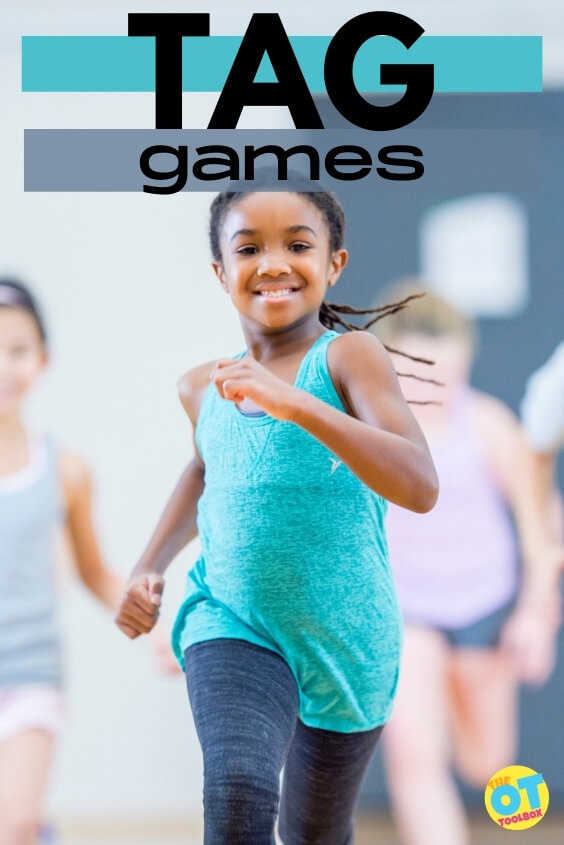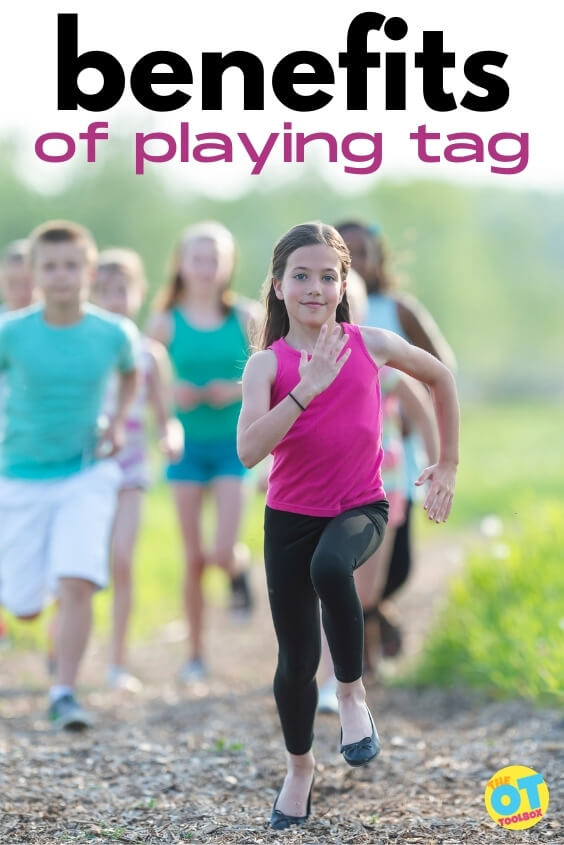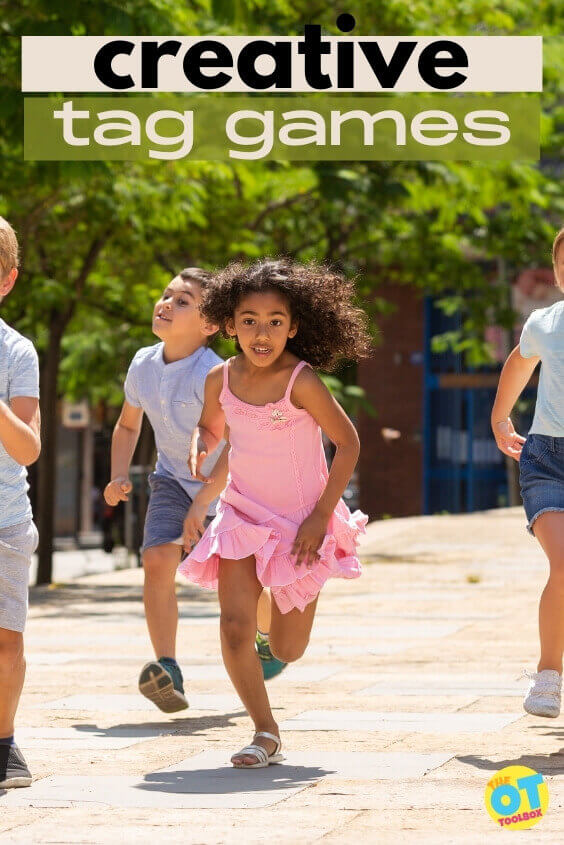The thing about playing tag games is that you can take a classic lawn game and make rules to change the game a thousand different ways and never play the same game twice! Chase games are a fun way to get kids moving and outside with movement, balance challenges, development of the visual system, and heavy work. Best of all? Tag activities can support developmental needs on all levels and abilities. Add these tag games to our massive list of outdoor lawn games to get kids moving, running, jumping, and building motor skills!

Tag games
There are so many reasons why tag games are a must for summer time fun. Let’s break it down:
- Tag games are great ways to add motor movement to kids, to get them off the screens, and outside. Running and playing tag supports gross motor coordination.
- Tag also is a powerful way to play together as a family, adding a chance for connection and creating memories. What better way to spend some time together as a family than playing a game of tag that offers heavy work, sensory input, in the great outdoors?
- Tag games are also great running games for physical education.
- Tag is a fun way to support therapy goals with a small group. Use the tag games in a group therapy setting, in PE planning, or in summer camp activities.
- Playing tag at summer camp offers a break between activities, adds heavy work, and can get kids moving and building skills. Best of all- you can modify the tag game to meet any theme or topic!
The options are limitless! Here are more summer camp ideas that tag can fit well into with therapeutic and team-building benefits.

Therapeutics benefits of playing tag
When kids are running, stopping, turning course, running around obstacles, there are many developmental benefits.
Let’s break down games of tags for their therapeutic benefits:
Running- running in short bursts offers cardio input that gets the blood pumping. When kids run and stop in short bursts, they are gaining heavy work input through their legs and core.
The short intervals involved in tag games build muscle strength, and allow for running at various speeds. As opposed to longer distance running, kids can be successful in running in short bursts.
This is also a great way to “reset” after being indoors for a while, on a long car ride, in the classroom all day, or on screen devices for a long period of time. We talked here about the benefits of treadmills and wellbeing, but for shorter bursts of running, the mindfulness benefits definitely exist!
Stopping and Starting- When we run and then stop abruptly or stop and turn, there are so many motor components occurring at one time.
The muscles that are actively engaged need to stop abruptly, adding heavy work input through those muscles and joints. Then the opposing muscles and core need to activate to maintain posture. The whole body is engaged in this action. Kids often play tag in a yard or park where there are trees or other stationary structures.
These provide a need to move around targets and slow running speed. This requires the visual processing system to interact with the motor tasks. When kids are running around other tag players, they are running around moving targets, which further engages muscles and visual processing system.
Stopping and starting motor skills are a challenge for:
- Proprioception
- Vestibular input
- Motor planning
- Body awareness
- Depth perception
- Balance
- Coordination
- Postural control
Tagging others- Tag is such a great way to interact with others in an appropriate way. You may have had a school yard experience where you were pushed down in a game of tag. When others tag you and it occurs unexpectedly or with too much force, a fall can happen!
However, by playing tag, kids get that experience with proprioceptive input, vestibular input, and visual motor skills.
- How much force must they exert to tag without pushing over a playmate?
- How far do they need to reach out to tag a friend without hitting their face?
All of this experience in movement is powerful! It helps kids learn about how their body moves in space, body awareness skills, visual perceptual skills, spatial awareness, and eye-hand coordination skills.
Spatial awareness- Expanding further on the spatial awareness skills, or spatial relations, body awareness, posture exercises for kids, and position in space, all of these body concepts are able to be carried over to other functional tasks.
This experience allows kids to use this knowledge when walking in crowded hallways without bumping into others, spatial awareness in handwriting on a page, moving while carrying plates or heavy items. All of these experiences can be integrated for functional movement.
Executive functioning skills- Playing a simple game of tag can build executive functioning skills, too! Think about it: when you play tag, there is working memory to recall movements that allowed you to escape in a previous game or trial.
If you’re playing a fun tag game version, you need to recall specific words or phrases that were already used. Other executive functioning skills that are used in tag include planning, prioritization of movements, impulse control, task completion, initiation, processing speed, self-monitoring, foresight, mindset, and cognitive shift. What a powerful game tag is in building cognitive skills!
Motor planning- Moving, making motor plans, running around obstacles and other children…what a great game tag is to build motor planning skills.
There’s more: tag is a fast-paced game. So those motor planning sequences and movements need to happen quickly. The good news is that a game of tag offers many trials and repetitions to build motor plans and muscle memory.
Visual Processing Skills- Visual processing skills is an umbrella of visual skills and tag addresses many of these areas through play. And playing tag requires many visual processing skills under that umbrella!
Take a look at all of the visual skills needed for tag:
- eye-hand coordination
- visual motor skills
- visual scanning
- visual tracking
- visual convergence
- visual discrimination
- form constancy
- visual figure ground
- peripheral vision
- visual efficiency,
- and visual acuity
What a powerful game tag is!
So, now that we know the massive therapeutic benefits of tag, let’s take a look at some fun tag games for kids.

Fun Tag Games
Classic tag–
Someone is it and chases the others in the group. When they touch someone else, that person is now “it”. The game continues.
TV Tag
One person is “it”. When they approach another person, the player yells the name of a TV show and drops to the ground. They are then safe and the person that is “it” needs to run and tag another person. This type of tag can be adjusted to call out music, songs, YouTube shows, games, sports, favorite foods, animals, etc.
Flashlight Tag–
Play tag in the early evening hours with flashlights. When you shine your flashlight on a fellow tag player, that player is tagged and they are now “it”. This is a great activity for challenging visual scanning skills, visual discrimination, visual figure ground, and visual tracking skills.
Sharks and Minnows Tag–
One person is the shark and the others are the minnows. When the shark touches another player, that person then turns into a shark. Now there are two sharks. Play until all of the minnows turn into sharks.
Freeze Tag-
When a person is tagged, they need to freeze in place until another player touches them to “unfreeze” them.
Cops and Robbers Tag-
A group splits into either “cops” or “robbers”. The cops chase the robbers and once tagged, they need to sit in “jail” until another robber tags them and releases them.
Pizza Tag-
One person is “it” and chases the others. Players run from “it” and can stay safe from being tagged by naming pizza toppings and touching the ground.
Animal Walk Tag-
Players can assume an animal walk (crab walks, hop like a bunny, waddle like a penguin, sway like an elephant, etc.) and play tag!
Social Distance Tag Games
No-Touch Tag Games-
Tag games can be modified to any theme which is great for social distancing. One person is “it”. When they near another child, that person yells out a word or phrase, or completes an action like hopping, squatting, acting like an animal, touching the ground, dabbing, or completing any physical action. Tag could take any action or theme in this way.
Shadow Tag-
Play classic tag but tag one another by stepping on the shadow of others. This is a great social distancing version of tag, as well.
Social Distancing Tag-
This tag game is another way to play with others, gain the benefits of tag, and play in a socially distanced form. Simply play tag in the classic version (or use any of the fun tag versions described here) and when “it” is within 6 feet of another person, they have tagged the other player. This is a nice way to work on spatial awareness and scanning at a distance, too.
Tag Games for Different Themes
The cool thing about a classic game of tag…or any of the versions listed above, is that you can adjust the theme to fit a weekly therapy theme, a summer camp theme, or a learning theme at school. Different types of tag games can be played using all one theme to add different movement opportunities and motor planning challenges.
- Have an ocean summer camp? Play ocean animals tag (kids call out ocean animals and drop to the ground to stay safe.)
- Planning a space camp? Play space tag. Kids can call out planets when the “it” person is near and stay safe.
- Creating a Pirates theme summer camp? Modify sharks and minnows tag to meet your theme.
- Coming up with a handwriting camp to work on handwriting skills? Encourage heavy work through the arms by adding crawling, hopping, or heavy work animal walks.
What do you think? Have you played any of these tag games before? Let’s get those kids moving!

Colleen Beck, OTR/L has been an occupational therapist since 2000, working in school-based, hand therapy, outpatient peds, EI, and SNF. Colleen created The OT Toolbox to inspire therapists, teachers, and parents with easy and fun tools to help children thrive. Read her story about going from an OT making $3/hour (after paying for kids’ childcare) to a full-time OT resource creator for millions of readers. Want to collaborate? Send an email to contact@theottoolbox.com.


